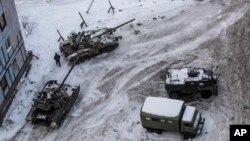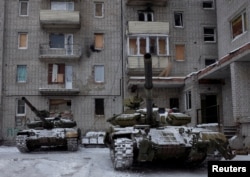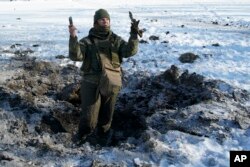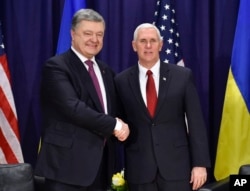A cease-fire in eastern Ukraine aimed at halting fighting between Ukrainian government forces and Moscow-backed separatists went into effect Monday. Ukrainian officials, however, warn it is at risk of falling apart.
Under the cease-fire announced in Munich by Russian Foreign Minister Sergei Lavrov, both sides are supposed to abide by the two-year-old Minsk agreement and withdraw heavy weaponry from the front lines.
Yet, just hours before the foreign ministers of Ukraine, Russia, France and Germany announced this latest truce, a separatist leader was issuing military threats.
Alexander Hug, chief of a monitoring mission for the Organization for Security and Cooperation in Europe, says there has been a significant reduction in armed incidents, noting that only small-arms fire was heard in the Donetsk region after the truce took effect at midnight, local time.
But Hug warned Monday that conditions for a flare-up were present as “heavy weapons remain on both sides of the contact area where they shouldn't be.”
Unlikely to hold
Analysts say the cease-fire is unlikely to hold, given that the underlying causes for the conflict remain unaddressed. Ukrainian officials are also skeptical, saying this truce will likely follow the pattern of the previous four cease-fires -- an immediate, but short-lived, reduction in violence, followed by an increase in clashes.
The previous cease-fires in a conflict that has left nearly 10,000 dead lasted for little more than a day.
Late Sunday, before the cease-fire went into effect, the warring sides traded mortar fire around the government-held town of Avdiyivka on the outskirts of Donetsk.
On Friday, Oleksandr Zakharchenko, leader of the Moscow-backed separatists in Donetsk Oblast, announced he was not bound by any deal involving the withdrawal of heavy weapons from the front. He also claimed the Ukrainian military will try to seize settlements in the buffer zone under the guise of the truce.
A key condition in the 2014 and 2015 Minsk agreements, which were mediated by Moscow and European governments, is that neither side should retain heavy weapons in the “contact area.” As reaffirmed in the cease-fire deal, both sides are to withdraw artillery systems with calibers of 100mm or more 50 kilometers from the contact line. Grad multiple rocket launchers may be no closer than 70 kilometers, while larger missile systems have to be at least 140 kilometers from the front.
Russian maneuvers
Overshadowing the cease-fire are growing concerns in Ukraine that Moscow is maneuvering to pressure or persuade the administration of U.S. President Donald Trump to accept a trade-off for peace in east Ukraine. The New York Times reported Sunday that Trump’s personal lawyer and a former business associate met with a pro-Moscow Ukrainian lawmaker last month in New York to discuss a peace plan that involves the de facto recognition of Russia's annexation of Crimea.
Kremlin officials maintain they had no knowledge of the meeting and called the peace plan absurd. “There’s nothing to talk about,” President Vladimir Putin’s spokesman Dmitry Peskov told reporters.
But Ukrainian officials told VOA they fear Moscow's maneuvers and worry some Trump advisers are eager to use Ukraine as a bargaining chip in a bigger strategic play to reset U.S.-Russian relations.
Asked about the meeting, Ukraine's ambassador to Britain, Natalia Galibarenko, told the BBC: “We are not trading our territories. We are not going to say, ‘Let us abandon Crimea and in return, let us see peace in Donbas'.”
"Donbas" refers to the part of southeastern Ukraine that encompasses the country's Donetsk and Luhansk oblasts.
US support
Over the weekend, before the New York Times story was published, Ukrainian President Petro Poroshenko attended a security conference in Munich, where he met with U.S. Vice President Mike Pence. Poroshenko was upbeat, emphasizing that he was reassured by firm pledges of support from Pence.
“We have once again received a powerful signal that the U.S.A. stands with Ukraine, that Ukraine is among the top priorities for the new U.S. administration," Poroshenko said. "The issue of Crimea and decisive struggle for the liberation of Crimea also remain among priorities."
The White House also stressed solidarity with Ukraine.
“The Vice President underscored U.S. support for Ukraine’s sovereignty, territorial integrity, and self-determination and underlined that the United States does not recognize Russia’s occupation and attempted annexation of the Crimean peninsula,” according to a White House statement.
Dozens have died in the Donbas region in recent weeks amid an escalation in fighting there between Ukrainian forces and pro-Russian separatists, especially around Avdiyivka.
Travel documents
Meanwhile, Putin signed an order recognizing travel documents issued by the de facto separatist authorities in Donetsk and Luhansk oblasts, further raising Ukrainian doubts about the sustainability of the truce. The Ukrainians claim the order effectively means Moscow has broken the Minsk agreement.
But the Kremlin argues the order only temporarily recognizes the separatist-issued documents and is in response to humanitarian need. The OSCE has warned the decision could reduce the chances that the cease-fire will hold.










